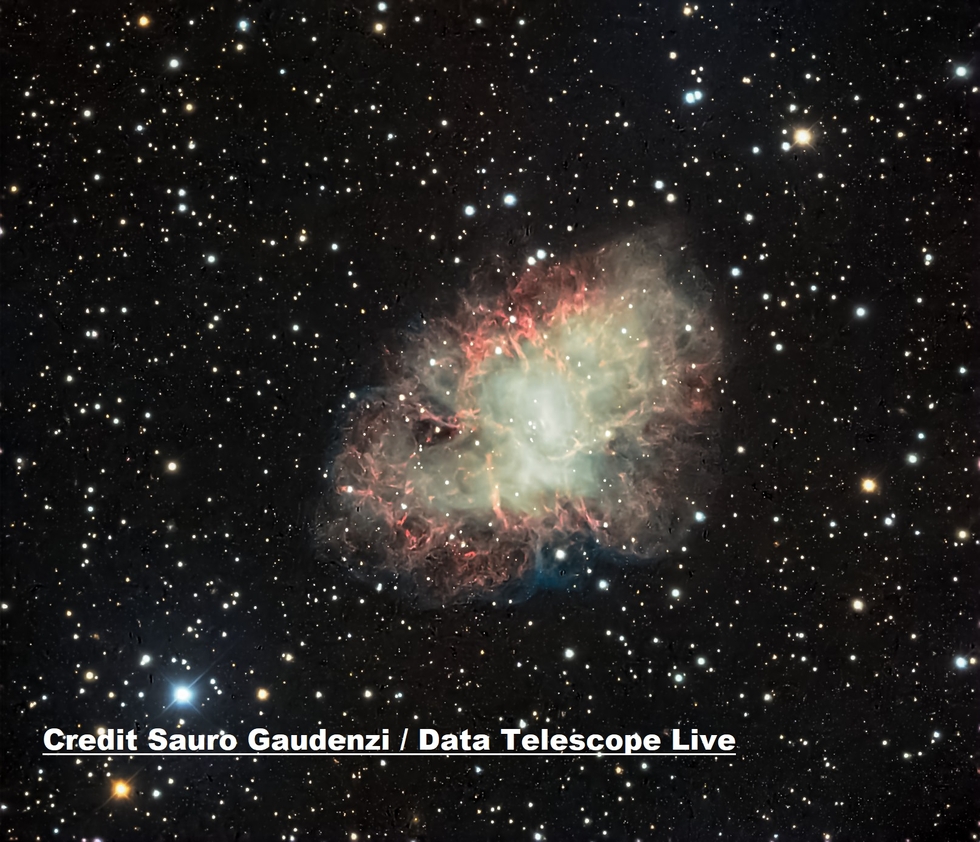M1 the Crab Nebula
M1 the Crab Nebula
The Crab Nebula (also known as the Crab Nebula or by the catalog abbreviations M 1 and NGC 1952) is a supernova remnant visible in the constellation Taurus. Discovered in 1731 by John Bevis, the nebula is the first object in the catalogue of astronomical objects published by Charles Messier in 1774.
The nebula, now more than six light-years across, is formed by the expanding gases ejected during the explosion of Supernova 1054; the gases are expanding at a rate of 1500 km/s and possess a total mass of about 4.6±1.8 M⊙. The supernova that produced it was observed for the first time on July 4, 1054 and was recorded by Chinese and Arab astronomers of the time; its brightness was such that the apparent magnitude of the event was between −7 and −4.5, making it visible to the naked eye during the day, surpassing the apparent brightness of Venus. The Crab Nebula is located about 6500 km from the solar system; therefore the event that produced it actually took place 6 500 years before 1054, i.e. about 5400 BC.
At the center of the nebula is the Crab pulsar (also known as PSR B0531+21), a neutron star with a diameter of about 28-30 kilometers, discovered in 1968: it was the first observation of an association between pulsars and supernova remnants, a fundamental discovery for the interpretation of pulsars as neutron stars.
The Crab Nebula is often used as a calibration in X-ray astronomy: it is very bright in this band, and its flux is stable, with the exception of the pulsar itself: the latter provides a strong periodic signal that can be used to control the timing of X-ray sensors. In X-ray astronomy, "Crab" and "milliCrab" are sometimes used as units of flow. Very few X-ray sources have a brightness greater than 1 Crab.
The nebula, now more than six light-years across, is formed by the expanding gases ejected during the explosion of Supernova 1054; the gases are expanding at a rate of 1500 km/s and possess a total mass of about 4.6±1.8 M⊙. The supernova that produced it was observed for the first time on July 4, 1054 and was recorded by Chinese and Arab astronomers of the time; its brightness was such that the apparent magnitude of the event was between −7 and −4.5, making it visible to the naked eye during the day, surpassing the apparent brightness of Venus. The Crab Nebula is located about 6500 km from the solar system; therefore the event that produced it actually took place 6 500 years before 1054, i.e. about 5400 BC.
At the center of the nebula is the Crab pulsar (also known as PSR B0531+21), a neutron star with a diameter of about 28-30 kilometers, discovered in 1968: it was the first observation of an association between pulsars and supernova remnants, a fundamental discovery for the interpretation of pulsars as neutron stars.
The Crab Nebula is often used as a calibration in X-ray astronomy: it is very bright in this band, and its flux is stable, with the exception of the pulsar itself: the latter provides a strong periodic signal that can be used to control the timing of X-ray sensors. In X-ray astronomy, "Crab" and "milliCrab" are sometimes used as units of flow. Very few X-ray sources have a brightness greater than 1 Crab.
SPECIFICATIONS
Telescope
SPA-2-CMOS
Camera
QHY 600M
Location
IC ASTRONOMY OBSERVATORY, SPAIN
Date of observation
15-10-2023
Filters
LRGB
Processing
Pixinsight and Photoshop
Credits
Credit Sauro Gaudenzi / Data telescope Live


